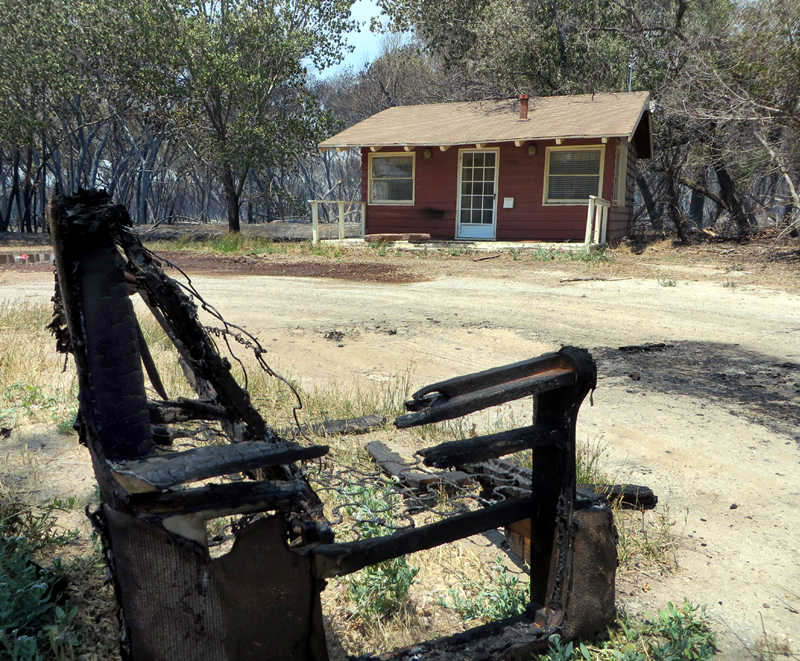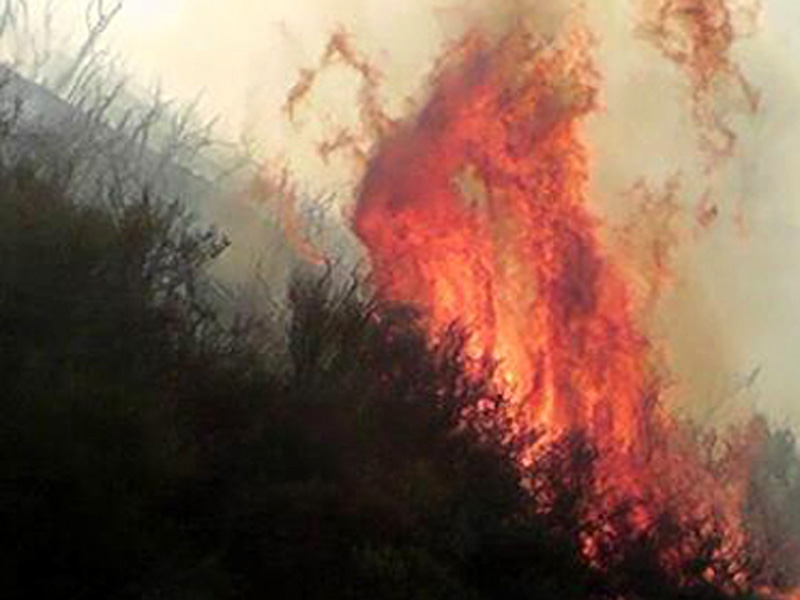|
|
Powerhouse Fire

Click image to enlarge
June 2, 2013 — The cabin made it through but the sofa didn't — on the west side of Ranch Club Road (behind the row of mailboxes), on the Ridgetop Ranch wetlands property. It's directly across the street from the defunct golf and RV resort. The fire scorched many trees on the wetlands property when it came through on Saturday evening, June 1, 2013, but it didn't incinerate too many because the fire was moving too fast. About the Ridgetop and golf ranch properties: The Lake Elizabeth Golf and Ranch Club, aka The Ranch at Elizabeth Lake, aka Lake Elizabeth RV Resort and Golf Course at 42505 Ranch Club Road (aka Drive) had been closed for about three years when the Powerhouse Fire came through the area June 1, 2013. The resort is located on the east side of Ranch Club Road, south of Elizabeth Lake Road, on the historic Frakes homestead, the site of a station along the Butterfield-Overland stagecoach route. The resort property spans 398 acres with an 18-hole, par-70 golf course that was designed by Mitchell A. Simon in 1962 as a 9-hole course and expanded to 18 holes in 1989. The resort includes a 113-space RV park, four manufactured units including an 8,400-square-foot clubhouse/banquet facility and pro shop, tennis and basketball courts, children's play areas and swimming pools. In 2007 the resort owner, Ridgetop Ranch Properties — a Montana real estate investor with a business presence in Lancaster, Calif. — won a $1.67 million lawsuit against E-Z-GO, a division of Textron, for manufacturing defective golf carts. Nonetheless, the golf course continued to draw complaints for lack of maintenance. But Ridgetop had ostensibly bigger problems than pitted greens. It owned 155 acres of wetlands, including the eastern half of Elizabeth Lake, and it wanted to sell. (The western half of the lake is U.S. Forest Service property.) Ridgetop’s wetlands were zoned for recreational use — hunting, fishing, boating, jet skiing, water skiing — and residents feared the loss of open space and habitat for more than 138 wildlife species, including some threatened and endangered ones, if the property were sold to a developer. The Lakes Town Council voted in 2008 to create a conservancy to work with local, state and federal officials to come up with the money to buy the wetlands property, and in June 2009 the county, at Supervisor Michael D. Antonovich’s behest, banned billboards and street lights and imposed a minimum-lot-size requirement of 2.5 acres in the area. At the same time, the recession that started in late 2008 was in full swing, and real estate prices were in freefall. Ridgetop listed the wetlands property (plus 16 acres zoned commercial) for $19.5 million. There were no buyers. Then in 2010, Bank of America foreclosed on Ridgetop’s golf resort. And there it languished until June 19, 2013. Two weeks after the Powerhouse Fire hit, the golf resort, which had been listed for $8.5 million, was sold in a bank auction for an undisclosed amount. The reserve was $600,000. The next chapter in the story of the east Elizabeth Lake wetlands across the street remains to be written. The Powerhouse Fire broke out Thursday afternoon, May 30, 2013, near Power House 1 (thus the name) in San Francisquito Canyon and quickly spread north. By the time the smoke cleared two weeks later, 30,274 acres (47.3 square miles) of brush were blackened, 30 homes were declared total losses, and another 28 outbuildings were destroyed. The Hughes and Elizabeth Lake communities bore the brunt of the devastation, which extended as far north as the Antelope Acres subdivision in south Lancaster. In Lake Hughes, four or five single-family homes burned completely to the ground on the evening of Saturday, June 1 — primarily on the south side of Newview Drive — when high winds, low humidity and dry fuels conspired for "perfect" fire conditions. Some of the old-growth chaparral hadn't burned since the 1920s. In all, nine firefighters were injured, either from falls, cuts and bruises, dehydration, heat exposure or poison oak (its ash is still poisonous). Some of them returned to the fire lines. The Federal Emergency Manangement Agency (FEMA) agreed to pay up to 75 percent of the cost of fighting the fire, preliminarily pegged at $23.4 million. The apparent point of origin was a hillside in the Angeles National Forest directly above the Los Angeles Department of Water and Power's northernmost of two power plants in the canyon, 11.5 miles past Copper Hill Drive in Santa Clarita and just beyond the former reservoir of the ill-fated St. Francis Dam. At 3:28 p.m. on May 30, "(t)he fire was first observed by a power plant station operator burning just north of the Power Plant 1 near San Francisquito Canyon Road," an LADWP statement said. The USDA Forest Service was first on scene and initially called off L.A. County firefighters who were dispatched to assist. When the flames jumped the road and it was apparent that containment was nowhere in sight, L.A. County Fire was called back, L.A. County Sheriff's units provided support, and the Forest Service took command of the incident. CAL FIRE, the state fire department, wasn't far behind. By evening the fire had consumed 1,000 acres and threatened Green Valley, whose residents were evacuated to a Red Cross center at Marie Kerr Park in Palmdale. Large animals went to the Antelope Valley Fairgrounds. Ultimately the fire didn't reach Green Valley; instead, the southern flank continued to burn near the power plant for days while the northern flank rushed toward Lake Hughes. First responders rounded up missing hikers; by Saturday evening the lake communities were evacuated and firefighters from multiple agencies were arriving to assist. The coming days would see 2,185 firefighters engaged in fire protection, mop-up, overhaul and structure protection. Although structures were lost, countless others made narrow escapes, thanks both to firefighters and to a number of residents who refused to evacuate. Such was the case of the Lakes Community Center, whose resident manager stayed behind. Many feared the center was lost; it wasn't. Nor was the HELUS elementary school (Hughes-Elizabeth Lakes Union School District), surrounded on three sides by fire. Papas Country Store made it through, as did the historic 1929 Rock Inn, which reopened at 4 p.m. the next day and became a de-facto information center. The Painted Turtle — a camp for chronically ill children, founded by Paul Newman at the site of the former Munz Lakes Resort — brushed with death as the flames licked several buildings. All major structures were saved (a barn and two sheds burned), but the grounds were completely destroyed and the buildings sustained heavy smoke damage. Officials were forced to call off the 2013 season and embark on "an extensive process of landscape cleanup and hydro-seeding, cleaning of all buildings and ventilation systems, and an ozone cleaning process of every building to ensure that The Painted Turtle facility meets the high level of safety that is the trademark of our program." Evacuees who had homes to return to in Lake Hughes and Lake Elizabeth faced more challenges. The L.A. County Department of Public Health advised them to boil their drinking water because the fire might have damaged water pipes and towers, and because downed power lines had forced officials to shut off power to the region during the fire, possibly reducing well pressure to a point where Total coliform and E-coli bacteria could spawn. Those who couldn't boil water were told to use ¼ teaspoon of bleach per gallon of clear water, or ½ teaspoon if it was cloudy. The stubborn fire made its last gasps for several more days on Sawtooth Mountain and the nearby Cottonwood Campground on Lake Hughes Road, southwest of town. The USDA Forest Service transfered incident command to L.A. County Fire for mop-up on June 10, 2013.
LW2396b: 9600 dpi jpeg from digital image by Leon Worden. |
The site owner makes no assertions as to ownership of any original copyrights to digitized images. However, these images are intended for Personal or Research use only. Any other kind of use, including but not limited to commercial or scholarly publication in any medium or format, public exhibition, or use online or in a web site, may be subject to additional restrictions including but not limited to the copyrights held by parties other than the site owner. USERS ARE SOLELY RESPONSIBLE for determining the existence of such rights and for obtaining any permissions and/or paying associated fees necessary for the proposed use.

















